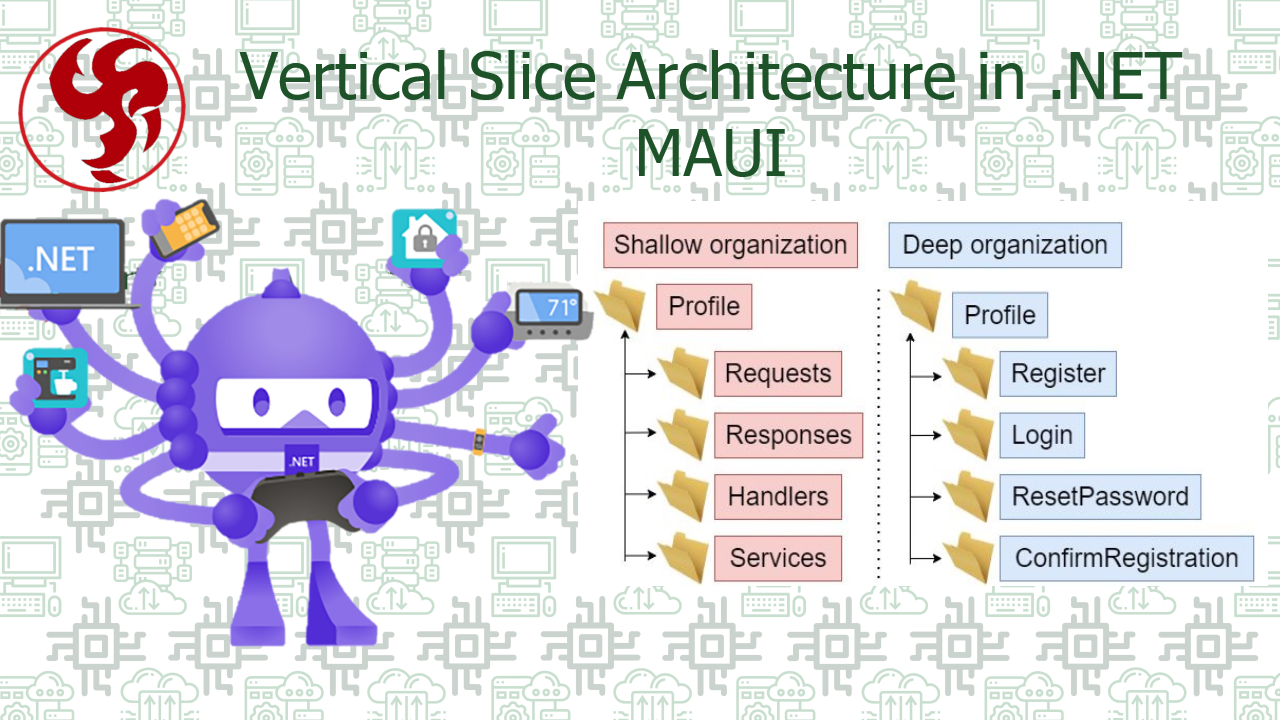Vertical Slice Architecture in .NET MAUI
📖 Introduction
For decades, software design has been dominated by the Layered (N-Tier) Architecture. We instinctively separate our apps into UI, Business Logic, and Data Access layers. But what if this separation, designed for clarity, actually becomes a source of complexity, friction, and slow development in modern mobile and cross-platform apps?
Enter Vertical Slice Architecture (VSA). Instead of organizing code by technical concerns ("how"), VSA organizes by features ("what").
Each feature is a self-contained slice that cuts through all layers, from the UI down to the database. This post will guide you through implementing this powerful pattern in your .NET MAUI applications, boosting your team's productivity and agility.
⚔️ Horizontal Layers vs. Vertical Slices: A Comparative
| Aspect | Traditional Horizontal Layers | Vertical Slices |
|---|---|---|
| Organization | By technical role (ViewModels, Services, Repositories) | By business feature (Login, UserProfile, Checkout) |
| Coupling | High: Layers are tightly coupled. Changing a service often affects everything above it. | Low: Slices are loosely coupled. Changes are isolated to a single feature. |
| Development Speed | Slows down as the app grows due to navigating multiple folders and managing dependencies. | Increases; teams can work on independent features with minimal conflict. |
| Onboarding | New developers must understand the entire architecture to add a simple feature. | Easier; a developer can understand and modify one feature without knowing the whole system. |
| Suitable for | Simple, CRUD-heavy applications with low change frequency. | Complex applications with many features and high agility requirements. |
🚀 Real Use Cases for VSA in .NET MAUI
- E-Commerce App: A "Product Checkout" slice would contain:
- UI (XAML + Code-Behind)
- ViewModel and Validation Logic
- Payment Service Integration (e.g., Stripe)
- Database commands to update inventory
- Benefit: You can completely overhaul the payment provider for this single feature without touching any code related to user profiles or product browsing.
- Social Media App: A "Create Post" slice with:
- The page for composing a post.
- Logic for handling text, camera, and image upload.
- The API call to submit the post.
- Benefit: Adding a new feature like "poll creation" becomes a new, independent slice, preventing bloat in a shared "PostService".
- Enterprise Field Service App: A "Submit Work Report" slice:
- MAUI UI for data entry and signature capture.
- Business rules for what constitutes a valid report.
- Off synchronization logic to submit the report when online.
- Benefit: Field agents need new data fields? Modify only the
SubmitWorkReportslice and deploy without worrying about breaking the "Parts Inventory" feature.
🧩 Step-by-Step Guide: Implementing VSA in .NET MAUI
Let's refactor a typical MAUI app to use Vertical Slices.
Step 1: Analyze and Define Your Features
Instead of folders like ViewModels, Services, and Models, your primary folders will be named after features.
Features/Authentication/UserProfile/Dashboard/Settings/
Step 2: Structure Your Project
A classic Horizontal Layer structure looks like this:
Refactor to a Vertical Slice structure:
Step 3: Implement a Feature ("Login")
1. Create the Feature Folder: Features/Authentication/ 2. Define a feature-specific interface within the slice. This is a key concept for maintaining independence.
3. Implement the ViewModel that depends only on its own feature's interface.
4. The concrete implementation of IAuthService lives in a Core/Infrastructure/ folder, ensuring separation of concerns. The ViewModel doesn't know how authentication works, just that it does.
Step 4: Register Dependencies in MauiProgram.cs
Step 5: Embrace Feature-Based Navigation
Instead of a central AppShell.xaml.cs that knows about every page, consider a more decoupled approach.
✅ Conclusion
Vertical Slice Architecture is a game-changer for .NET MAUI development. It trades the superficial comfort of technical separation for the real-world benefits of feature-based cohesion.
- 👍 Pros: Enhanced maintainability, reduced coupling, faster development cycles, and better team scalability.
- 👎 Cons: Can feel unfamiliar at first and might lead to some initial duplication (e.g., similar
DTOsin different slices), which is often a worthy trade-off for isolation.
By organizing your code around what your application does rather than how it is built, you create a system that is easier to understand, extend, and test. For any .NET MAUI project that is expected to grow and evolve, adopting a Vertical Slice approach is a powerful strategic decision.
🔗 References & Further Reading
- Official .NET MAUI Documentation - Microsoft's guide to getting started with .NET MAUI.
- Jimmy Bogard - Vertical Slice Architecture - The seminal article on the concept from its creator.
- Onion Architecture - A complementary architecture that often pairs well with VSA.
- MediatR Library - A popular .NET library that enables the "mediator" pattern, often used to implement vertical slices. While not covered in this intro post, it's the natural next step for advanced VSA.
